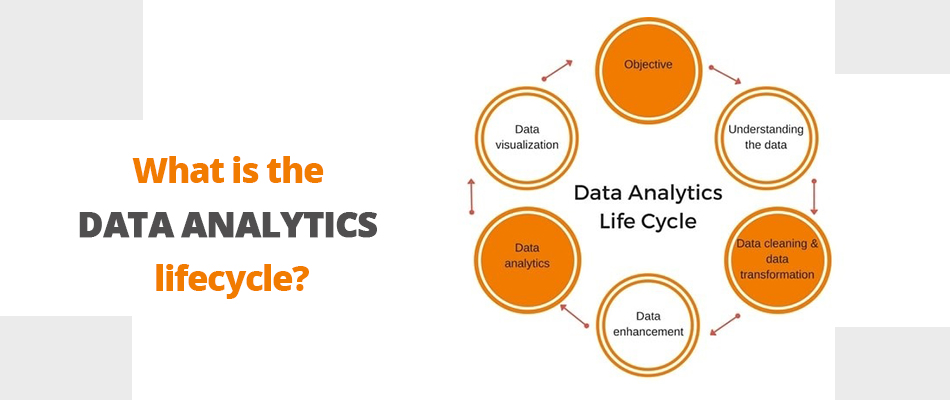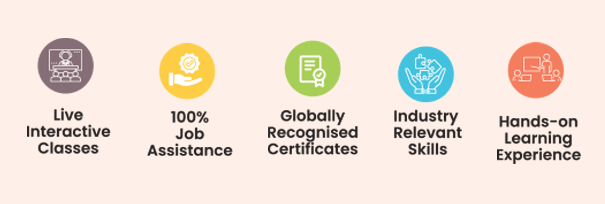In today’s digital world, data has come to play a very crucial role. Data goes through an entire lifecycle of itself including being created, consumed, processed, tested, and reused. However, understanding Data Analytics lifecycle is not limited to only knowing the umbrella processes. Every single stage of the Data Analytics lifecycle is important and thus, if you are someone who is looking to become a data analyst in the country, then it is essential you know about the process because it is one of the key things to know about.
Every single stage is important and plays an important role in determining the outcome we get after this entire cycle. The productivity and the accuracy level of the outcome is highly dependent on how well the data analyst carries out these steps. The nature of Data Analytics lifecycle is cyclic, wherein the steps keep moving around in circles, one after the other happening continuously.
Data Analytics architecture is not entirely defined. While experts are always discussing more about the right defined path to take, they are yet to come to a conclusion as to what step needs to come first and what needs to follow accordingly. Since there is no concrete path to be followed, every Data Analytics expert takes the one that they deem fit. Hence, sometimes, entire stages are skipped or even added.
The key reason behind the creation of the Data Analytics lifecycle, sometimes also referred to as the business analytics cycle, was to address problems associated with data science and big data.
There are 6 essential steps in the Data Analytics lifecycle that strive to cover the basic steps of acquiring, processing, analysing and recycling data properly. Let us take a closer look at the Data Analytics lifecycle.
The Phases of Data Analytics lifecycle
A scientific method has been devised to bring the Data Analytics lifecycle to life and has been divided into six essential steps or phases. This framework has been deemed fit because of its simple and cyclic nature. Thus, the steps are followed one after the other and even repeatable. Since they are cyclic in nature, these phases can also be followed either in a forward manner or in a backward manner.
Phase 1 – Data Discovery & Formation
Everything needs to begin with a set purpose and the first phase is dedicated to that. defining the goal of what you need to achieve with the data you acquire and how you wish to achieve it as you come close to finishing the Data Analytics lifecycle is what this initial phase all about.
Defining your data’s purpose is of importance. In this phase, you will be making evaluations and assessments that you need to come up with in order to make basic hypothesis to be able to resolves all the challenges and problems the organization is facing.
Here you will map out the potential use, along with the requirement of data in the sense that you get answers to the source of the information, the story/ answer you wish you data to convey and how the outcome should impact the organization. Being a data analyst, you will have to get acquainted with the business industry, scrutinize the ongoing business trends, and research on similar data analytics case studies.
Thus, you structure the business problems in the shape of an analytics challenge and formulate the IHs or Initial Hypothesis to start learning and testing the data.
Phase 2 – Data Preparation & Processing
While the first phase was all about information requirements, this second phase is all about business requirements.
The accumulated data needs to be collected, processed and cleansed in this phase. It is also ensured that all necessary or required data is available to be used and processed. Data is collected using a lot of methods including –
Data Acquisition – gathering information from all possible and trusted external sources
Signal Reception – gathering information from all digital devices including the IoT (internet of things) and control systems
Data Entry – formulating all recent data using with the help of manual data entry techniques or digital systems within an enterprise
Analytical sandbox is an important term here in this data preparation stage. This is a scalable platform which is used by data scientists and data analysts to process data. This analytical sandbox is equipped with data that was once transformed, executed and loaded into the sandbox. This phase of the Data Analytics lifecycle can be repeated later if the expert feels the need for the same.
Phase 3 – Design a Model
Once you have gone through the first two steps of mapping out your business goal/ problem and having collected a glut of data that includes unstructured, semi- structured or structured data, it is time to move onto the designing and building of a model, with the help of which we will be able to utilize the data to the fullest to achieve the goal. Hence, this phase has been termed as model planning.
A myriad of techniques are available in the market to facilitate the loading of data into the system to be able to start studying it. here are some of those –
ELT – acronym for Extract, Load and Transform, ELT primarily loads the raw data into the sandbox, which is then transformed.
ETL – acronym for Extract, Transform, and Load, ETL first transforms the data with the help of a fixed set of business rules and then loads it into the sandbox.
ETLT – acronym for Extract, Transform, Load, Transform, ETLT is a mixture of sorts wherein the transformation happens at two levels.
Data sets are basically developed by the expert team in order to test, produce and train the data. Once this is done, the team moves on to build and execute the models that had been created in the model planning stage.
Phase 4 – Model Building
The fourth phase of the data analytics architecture includes developing data sets for the purpose of testing, training and production. The Data Analytics experts work meticulously to build and operate an ideal model which has been designed in the step before. These team members rely on various different techniques such as regression techniques, neutral networks and decision trees for building and executing the model.
A trail run is also conducted to ensure whether the current tools are sufficient or more needs to be added.
Phase 5 – Result Communication & Publication
This step is in direct relation to the first step because the goal that you wished to achieve via their Data Analytics lifecycle should have taken a shape till now. The tests that have been run should have met the criteria set down.
Communication, as a phase, includes collaborating with major stakeholders in order to determine whether the project results can be termed as a failure or success. The team is asked to identify all the key findings of the analysis conducted, measure the business value linked with the result and finally produce a narrative that summarises and conveys the same to the stakeholders.
Phase 6 – Measuring of Effectiveness
As the final step to the Data Analytics lifecycle, the Data Analytics team needs to cumulate a detailed report inclusive of all the key findings, technical papers/ documents, briefings and coding to the stakeholders.
Additionally, in order to measure the effectiveness of the analysis, the data is shifted from the sandbox to a live environment and monitored for observation regarding the similarities between the result and the expected business goals. If the result happens to be positive, the reports as well as the results are finalised. On the contrary, if the result deviates from the intent concluded in the phase 1, experts move back to any previous phase in the Data Analytics lifecycle in order to come up with a different outcome.
Benefits of Data Analytics lifecycle
There are quite a few benefits of the Data Analytics lifecycle including, but not limited to –
- Data Analytics lifecycle gives us an outline about the creation, gathering, processing, utilization and analysis of the data in order to meet the corporate objective.
- The Data Analytics lifecycle gives guidance and the techniques necessary for extracting information from the data and moving forward to be able to achieve all corporate objectives.
- The Data Analytics lifecycle offers a structured method necessary for handling data so that it can be applied for the achievement of project and organizational objectives.
Conclusion
Big data and analytics are technologies that are being used by most medium to large- scale enterprises across the globe in order to achieve success. Since the quantity and quality of businesses incorporating big data and analytics, it is pretty obvious that the job opportunities in these fields as well as related ones are going to keep flowing in.
Become a part of the ever- expanding field of data analytics by enrolling with Grras Solutions’ Data Analytics training and certification course. Begin your journey with the best and ensure success because the first step is what matters the most. Take the very best first step today with Grras Solutions.






